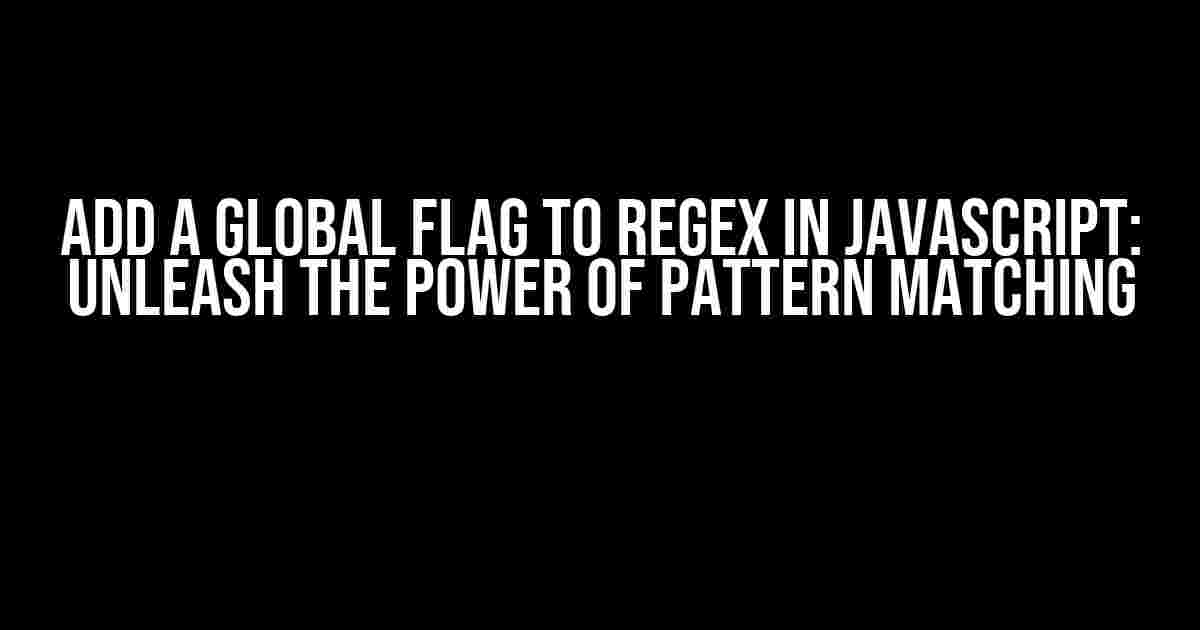When working with regular expressions in JavaScript, one of the most important flags to understand is the global flag. In this article, we’ll dive into what the global flag does, how to use it, and why it’s essential for effective pattern matching.
What is the Global Flag?
The global flag, represented by the letter “g”, is a flag that can be added to a regex pattern to perform a global search. By default, regex patterns in JavaScript search for a single match in a string. However, with the global flag, the regex engine will search for all matches in the string, not just the first one.
Why Do I Need the Global Flag?
Imagine you’re working on a project where you need to find all occurrences of a specific pattern in a large string. Without the global flag, your regex pattern would only match the first occurrence, and you’d be left with a bunch of manual string manipulation to find the remaining matches. The global flag solves this problem by allowing you to find all matches in one go.
How to Add the Global Flag to a Regex Pattern
Adding the global flag to a regex pattern is straightforward. You can do it in one of two ways:
/pattern/g: This is the most common way to add the global flag. Simply append the letter “g” to the end of your regex pattern.new RegExp('pattern', 'g'): If you’re using the RegExp constructor, you can pass the global flag as the second argument.
Example 1: Finding All Digits in a String
const str = "Hello, my phone number is 123-456-7890.";
const regex = /\d/g;
const matches = str.match(regex);
console.log(matches); // Output: ["1", "2", "3", "4", "5", "6", "7", "8", "9", "0"]
In this example, we’re using the global flag to find all digits in the string. Without the global flag, the regex engine would stop at the first match, which is the digit “1”.
Example 2: Replacing Multiple Instances of a Pattern
const str = "Hello, my name is John Doe.";
const regex = /John/g;
const newStr = str.replace(regex, "Jane");
console.log(newStr); // Output: "Hello, my name is Jane Doe."
In this example, we’re using the global flag to replace multiple instances of the name “John” with “Jane”. Without the global flag, only the first occurrence would be replaced.
Common Pitfalls to Avoid
When working with the global flag, there are a few common pitfalls to avoid:
| Pitfall | Description |
|---|---|
| Not using the global flag | If you forget to add the global flag, your regex pattern will only match the first occurrence. |
| Using the global flag with the exec() method | The exec() method will only return the first match, even with the global flag. Use the match() method instead. |
| Not handling multiple matches correctly | When working with multiple matches, make sure to handle each match correctly, such as by using a loop or an array. |
Best Practices for Using the Global Flag
To get the most out of the global flag, follow these best practices:
- Use the global flag with caution: Only use the global flag when you need to find all matches in a string. It can lead to performance issues if used unnecessarily.
- Test your regex pattern: Make sure to test your regex pattern with and without the global flag to ensure it’s working as expected.
- Handle multiple matches correctly: When working with multiple matches, make sure to handle each match correctly, such as by using a loop or an array.
- Use the match() method: The match() method is the recommended way to use the global flag, as it returns an array of all matches.
Conclusion
The global flag is a powerful tool in the world of regex in JavaScript. By adding the global flag to your regex pattern, you can find all matches in a string, not just the first one. Remember to use the global flag with caution, test your regex pattern, handle multiple matches correctly, and use the match() method to get the most out of this powerful feature.
Now that you’ve mastered the global flag, go ahead and unleash the power of pattern matching in your JavaScript projects!
Here are 5 Questions and Answers about “Add global flag to regex js”:
Frequently Asked Question
Get the scoop on how to add a global flag to regex in JavaScript!
What is the purpose of adding a global flag to regex in JavaScript?
The global flag, also known as the “g” flag, allows the regex engine to search for all matches in a string, not just the first one. This is especially useful when you need to find multiple occurrences of a pattern in a string.
How do I add a global flag to a regex pattern in JavaScript?
To add a global flag to a regex pattern, simply append the “g” flag at the end of the pattern, like this: `/pattern/g`. For example, `/hello/g` will search for all occurrences of “hello” in a string.
What happens if I don’t add a global flag to my regex pattern?
If you don’t add a global flag to your regex pattern, the regex engine will only search for the first match in the string and stop there. This can lead to incomplete results if you need to find multiple occurrences of a pattern.
Can I use the global flag with other regex flags?
Yes, you can use the global flag in combination with other regex flags, such as the “i” flag for case-insensitivity or the “m” flag for multiline matching. Simply append the flags to the end of the pattern, separated by commas. For example, `/pattern/gi` will search for all occurrences of the pattern in a case-insensitive manner.
Are there any performance considerations when using the global flag?
Yes, using the global flag can have performance implications, especially with large strings and complex patterns. This is because the regex engine has to search the entire string for matches, which can be time-consuming. However, if you need to find all occurrences of a pattern, the global flag is a necessary optimization.





